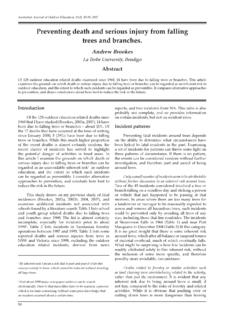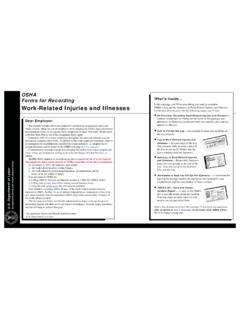Transcription of Sample Letter to OSHA - Ironworkers
1 REINFORCING STEEL AND POST-TENSIONING SAFETY ISSUES p. 1 - Sample Letter to osha p. 3 - osha s Request for Information - Reinforcing Steel and Post-Tensioning Safety Issues Sample Letter to osha osha Docket Office Docket No. osha -2010-0058 Technical Data Center, Room N-2625 Department of Labor 200 Constitution Avenue NW Washington, DC 20210 Re: Occupational Safety and Health Administration Docket No. osha -2010-0058 Support for New osha Standards for Reinforcing Steel and Post-Tensioning Operations Attention: Occupational Safety and Health Administration: On behalf of (insert company name), I am writing to urge the Occupational Safety and Health Administration ( osha ) to pursue rulemaking and adopt new safety standards pertaining to reinforcing steel and post-tensioning operations. Attached are responses to the Agency s Request for Information (RFI) pertaining to this proposed rulemaking initiative.
2 We support the position of the industry coalition of reinforcing stakeholders that includes The International Association of Bridge, Structural, Ornamental and Reinforcing Iron Workers, Ironworker Management Progressive Action Cooperative Trust, National Association of Reinforcing Steel Contractors, Concrete Reinforcing Steel Institute, Post Tensioning Institute, Western Steel Council, Department of Reinforcing Ironworkers Advisory Committee, and The Center for Construction Research and Training. The primary considerations of the industry coalition of reinforcing stakeholders to pursue new osha standards for reinforcing steel and post-tensioning operations are based on the following rational. 1. The current osha Subpart Q Concrete and Masonry standard is antiquated and contains limited safety provisions for several recognized hazards associated with reinforcing steel and post-tensioning activities.
3 2. Fatality and accident trends in the reinforcing steel and post-tensioning industry indicate a direct correlation between accident causation factors and lack of specific regulations. 3. The use of steel reinforcement and post-tensioning in poured in-place concrete is expected to double by 2015 from its 1990 level and may comprise a majority of commercial and industrial construction. 4. The Negotiated Rulemaking process will produce the best safety standard and regulations through the cooperative efforts of osha , stakeholders, and experts in the reinforcing steel and post-tensioning industry. An overview of fatalities, accident trends and causation factors was presented to osha from representatives of the Iron Workers International and IMPACT. Subsequent meetings with Agency officials were held to reviewed specific osha fatality data relating to the following reinforcing activities.
4 More detailed information and recommendations pertaining to incidents and hazards are provided in the attached responses to Agency s RFI. Examination of Fatalities, Accident Trends and Causation Factors 1. Material Handing injuries Many Ironworkers have sustained material handling injuries due to inadequate and unacceptable jobsite conditions. Reinforcing Ironworkers and contractors are currently not provided with the same safety provisions for site conditions as steel erection contractors and Ironworkers under the Subpart R Steel Erection Standard. 2. Structural Collapse of Vertical Formwork and Decks Fatalities and disabling injury trends have continued to occur due to the lack of specific osha standards. The current Subpart Q standard does not adequately address responsibilities to ensure formwork stability.
5 osha needs to adopt new standards to address the responsibility for the appropriate parties to inspect the structural integrity of formwork prior to allowing access of personnel and materials. 3. Structural Collapse of Vertical and Horizontal Columns Fatalities and disabling injury trends continue to occur to due to the lack of specific guying and bracing requirements for vertical and horizontal columns. The current Subpart Q standard does not adequately address specific requirements and responsibility for guying and bracing of columns. 4. Impalement by protruding Reinforcing Steel Dowels Many serious incidents and legal issues involve the use, inspection, and responsibility to maintain dowel impalement covers during reinforcing steel activities continue to occur in the reinforcing industry.
6 The current Subpart Q standard does not adequately address impalement hazards and responsibilities of appropriate parties to during the reinforcing steel process. 5. Post-Tensioning Standards Serious incidents and fatalities continue to occur involving the use of post-tensioning equipment. The use of post-tensioning cables and equipment is expanding that warrants the need for new osha standards. Specific standards pertaining to training and the use of post-tensioning equipment are needed to help prevent workplace hazards and reoccurring incidents during post-tensioning operations. We strongly urge osha to pursue rulemaking and adopt new safety standards pertaining to reinforcing steel and post-tensioning activities. Thank you for your consideration to grant our request. Sincerely, (Your name here) Title and company name cc: Eric Dean, General Secretary, Iron Workers International; Steven Rank, Executive Director of Safety and Health, Iron Workers International osha s Request for Information Reinforcing Steel and Post-Tensioning Safety Issues Following are specific questions from osha s RFI seeking comments and information from industry stakeholders.
7 We want to provide the Agency with consistent answers to these questions that reflect our position. A. Post-Tensioning Operations 1. Are there specific post-tensioning hazards not currently addressed by osha standards? If so, what are they? There are several hazards and processes pertaining to post-tensioning operations that are not adequately addressed by the current osha standards. Some of the hazards include but are not limited to the following. a) Concrete blow-outs on decks, beams, or joists b) Explosive release of a cable during tensioning operations c) Trips on materials d) Falls to exterior of building during jacking operations e) Lacerations from cable ends f) Impalement from cable ends g) Air-hose breaks h) Flying debris & equipment A video that illustrates blow-out hazards during post-tensioning operations cab be viewed at: +tension+blowout&oq=post+tension+blowout &aq=f&aqi=&aql=&gs_l= 2.
8 What are the most common post-tensioning-related injuries , and what procedures or techniques are available to prevent them? The most common injuries include but are not limited to broken bones, impalement, lacerations, blunt force trauma from jack or cables, eye punctures, etc. a) Serious struck-by injuries from the hydraulic rams have occurred to Ironworkers during the stressing operation. This involves several factors such as the ram rifling due to excess bare strand behind the anchor; the ram slipping off the cable due to worn jack grippers; the cable not perpendicular to the anchor due to improper concrete placement; the cable being pulled out of the dead end or coupler due to the wedges not being properly back stressed; honeycombing of concrete causing the stressing anchor to slip or blowout; improper placement of cable and/or bursting steel/anchor reinforcement; cable breaking due to improper cleaning of the anchor cavity causing the wedges to seat unevenly; cable stressed in excess of specified pressure; personnel standing to close to the ram.
9 B) The other common accident is lacerations caused from improperly unrolling the cable and cables being placed through the beam-side. c) Workers entering areas where post-tensioning operations are occurring have been hurt and specific standards are need to bar them from entering these areas. The controlling contractor is the best entity to ensure that other trades are not allowed in these areas. d) The procedure to avoid these injuries is proper training such as the training that is performed by the Ironworkers through apprentice, journeyman upgrading programs, and the Post-Tensioning Institute (PTI). Procedures and techniques to prevent serious injuries during post-tensioning operations include the following proposed requirements. a) Need for notification - No stressing operations shall commence prior to the controlling contractor providing written documentation to the company performing the stressing operation that the minimum specified initial concrete compressive strength has been achieved.
10 B) Expanded requirements - No one shall be permitted to stand behind, in line with or directly above the stressing equipment or the full length of the tendon(s), including the fixed end anchorage. c) Signage requirements - Signs and barriers shall be erected to limit access into the stressing area only to personnel engaged in stressing or de-tensioning operations. d) Controlling contractor involvement - The controlling contractor shall bar other construction processes from being worked in barricaded areas during stressing operations. e) Access requirements - The controlling contractor shall ensure that an adequate safe work platform of a minimum of (3) feet (this can include an extension of formwork) including handrails, or equivalent, is provided for stressing tendons, cutting tendon tails, and grouting. All work platforms shall be clear of any materials not related to the work process.







